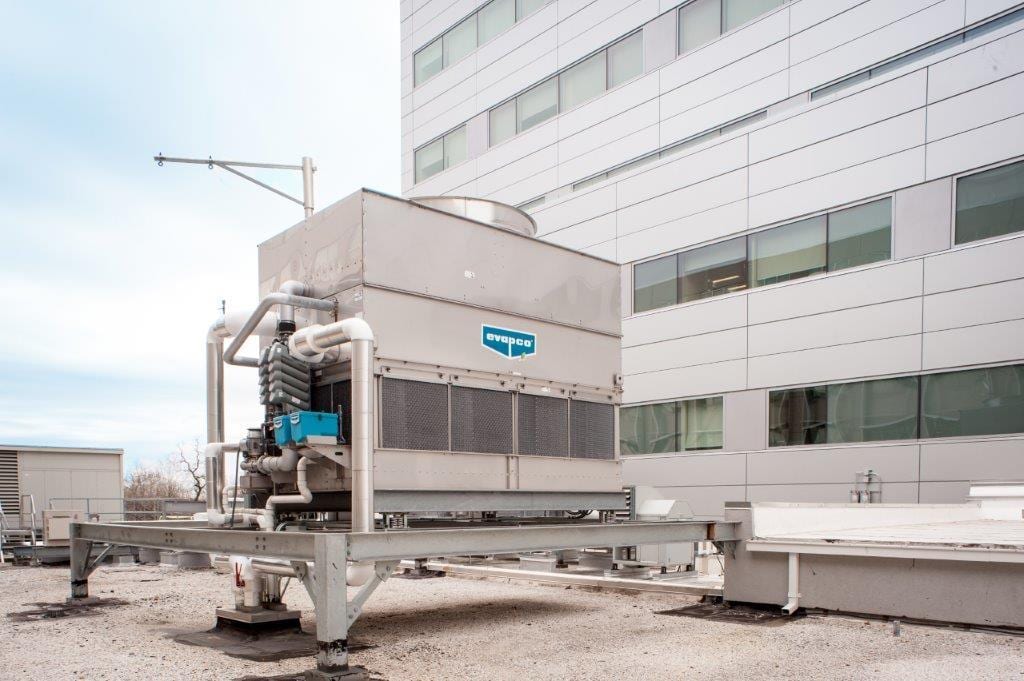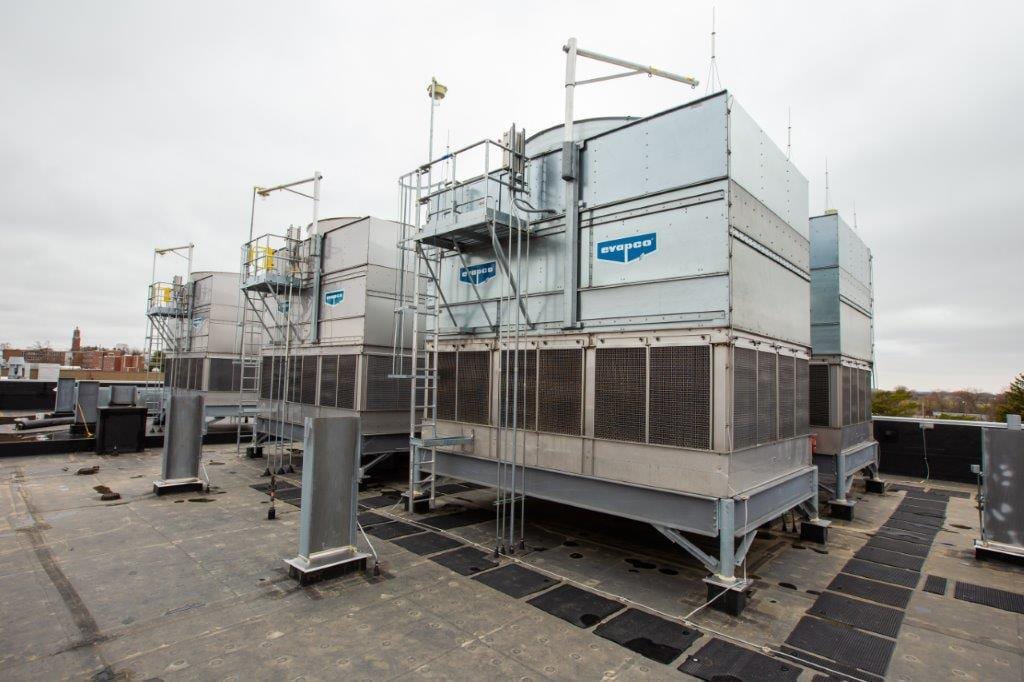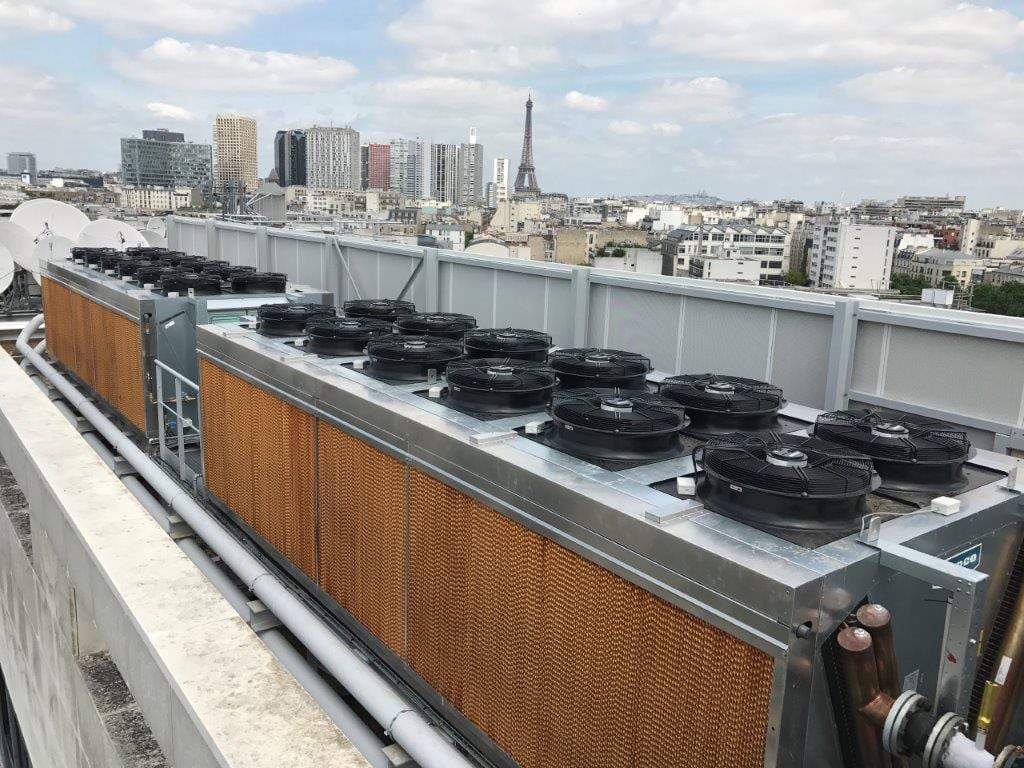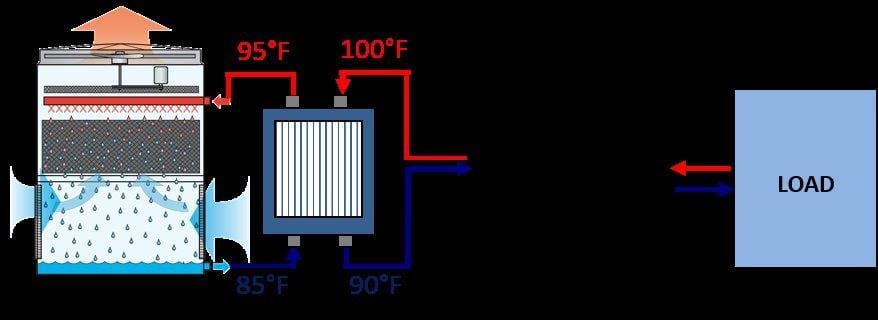




feature
The Closed-Loop Advantage
Given the growing sensitivity to water conservation, and the ever-increasing cost to maintain mechanical systems, closed-loop technology is quickly gaining traction nationwide.
FIGURE 1: A closed-circuit cooler.
Photos courtesy of Evapco.

It’s a common question during the early design phase of large mechanical systems: Is open- or closed-loop cooling equipment better suited for this project?
When it comes to modern heat-rejection technology, both open- and closed-loop cooling equipment provide a distinct set of advantages for engineers, installers, and building owners. The specific cooling needs of the application, along with the physical parameters of the installation site, budgetary considerations, and environmental goals, should ultimately determine the type of system that’s best-suited and specified.
With very real concerns about the higher water consumption of open-loop systems, closed-loop cooling technology is gaining broader appeal every year. When properly designed for commercial or industrial process cooling loads, both system types can offer unparalleled energy efficiency, reliability, and longevity.
Determining which system is best-suited to a certain application is a task left for specifying engineers and others who are intimately familiar with the needs of the property.
Whether open- or closed-loop heat rejection equipment is specified, engineers should strongly consider selecting equipment that is Cooling Technology Institute (CTI)-certified.
Open-Loop Equipment
The most prevalent type of large-scale heat rejection equipment in use today is the open-loop cooling tower. These systems are known for their expansive range in available capacities and configurations, reasonable first-costs, and energy efficiency. However, there are several trade-offs when compared to closed-circuit alternatives. Among the largest compromises with open-loop technology are water consumption and the level of maintenance and water treatment required.
With open-loop equipment, process fluid enters the top of the cooling tower and flows over the fill (or heat transfer media). At this point, the process water is open to outdoor air and any contaminants present in the atmosphere. Falling from the fill, water collects in a basin before returning to the facility’s cooling loop.
Due to airborne pollutants, incoming contaminants from the makeup water supply, and the presence of absorbed oxygen, proper maintenance of all equipment in the loop is critical. This also heightens the importance of water/fluid filtration and treatment. If the process water in the basin of the open tower is not properly treated, filtrated, and maintained, the energy efficiency of the system will be reduced over time due to scaled and/or fouled heat exchangers and chiller tubes.
FIGURE 2: An open-loop tower.

Open loop cooling tower with heat exchanger
There are a variety of applications where an open-loop cooling tower is the best option for heat rejection. Facilities that are not facing the need to minimize water consumption may benefit from this system type, as would a property needing to maximize the amount of heat-rejection capacity in a limited mechanical footprint. However, a closed cooling circuit is still highly recommended for the fluid’s process heating and/or cooling loop(s).
In these situations, isolating the cooling tower from the process loop through the use of a heat exchanger may provide an ideal solution. In this way, the benefits of a cooling tower can be provided without requiring the maintenance an open cooling loop requires. Isolating the system from the cooling tower through the use of a heat exchanger also eliminates concern for where the heat rejection equipment is installed in respect to the cooling loop.
Plate-and-frame heat exchangers are most frequently used for this type of design. When a heat exchanger is installed, the cooling tower must be sized properly to accommodate the temperature difference between the cooling tower water entering the heat exchanger and the process water that exists within the heat exchanger.
Isolating the cooling tower with a heat exchanger will substantially reduce the need to maintain downstream components. However, this also means the heat exchanger will require routine maintenance. To ensure both the thermal performance and pressure drop across the heat exchanger meet design requirements, heat exchangers should be certified per Air-Conditioning, Heating, and Refrigeration Institute (AHRI) Standard 400.
FIGURE 3: An adiabatic cooler.

Closed-Loop Technology
Evapco, and many other cooling tower manufacturers, offers a wide range of closed-circuit coolers or, “fluid coolers,” to provide a heat-rejection alternative for engineers or end users who want (or need) to reduce water consumption and equipment maintenance.
Some cooling applications require a closed-loop system for peak efficiency and long-term operation. These types of systems generally include the use of small heat exchangers in terminal units or other connected equipment, making maintenance complicated if at all possible.
For example, buildings with water-source heat pump loops — widely used for office, hotel, high-rise residential, and health care facilities — are among the largest markets for fluid coolers. Using an open cooling loop could pose the significant risk of fouling hundreds of heat exchangers in a condominium or similar facility. Closed-circuit systems are also prevalent among data centers, battery plants, grow room facilities, high-efficiency chiller applications, and multiple different types of industrial process loops.
Water loss through evaporation is either reduced or eliminated, depending on the type of closed-loop cooling equipment selected.
FIGURE 4: A dry cooler.

The same is true for water treatment chemicals and/or systems; closed-loop technology can help dramatically reduce or even eliminate the need for chemical treatment of system fluids.
While open-loop cooling towers reject heat in a smaller footprint than closed-loop fluid coolers (due to the process fluid being cooled via direct latent heat transfer), closed-loop systems benefit from sustained thermal performance of the entire system. Higher whole-system efficiency over time is achieved because heat transfer surfaces experience less fouling. Closed-loop systems also typically require less pumping horsepower than open-loop systems of similar capacity.
With a closed-loop system, there are significant installation savings attributed to the reduced pumping horsepower (hp) required, the elimination of an intermediate plate-and-frame heat exchanger, and the removal of expensive valves and additional pipework. This is coupled with the lifetime operational savings, including reduced water treatment/chemicals, water consumption, and maintenance.
Comparing just an open tower to a closed-circuit cooler in terms of price does not tell the whole story when considering the upfront additional installation costs and operational costs of an open-loop system.
Because the clean system fluid provided by a closed-loop design reduces maintenance and wear to all connected components, the equipment’s life cycle is lengthened. Reducing maintenance also results in less downtime, which is particularly important for data centers and critical process cooling applications.
Compared to open-loop cooling towers, fluid coolers provide more flexibility in terms of where heat rejection equipment is installed. Closed-loop systems also do not require hydraulic balancing or equalization. Because of this, fluid coolers can be installed at or below the level of the connected system piping. Conversely, installing a cooling tower below grade or the pump could result in the tower flooding when the unit shuts down.
Closed-loop equipment also provides an advantage for cooling systems operating in subfreezing outdoor temperatures. Some types of closed-loop equipment may still require freeze protection of some sort, but all open-loop cooling towers must be equipped with basin heaters, a drain-back design, or a recirculation system for idle periods in freezing conditions.
Closed-circuit coolers can also provide completely dry sensible heat rejection when outside ambient conditions are favorable. This dry capacity is an added benefit that can greatly reduce the overall water consumption on a project. Fluid coolers can be sized for full design or partial load based on a dry bulb switchover temperature. This means the recirculating spray pump can be de-energized when the heat load can be fully satisfied by just the fluid cooler fans. While this operational mode greatly reduces water consumption, energy is also saved since the recirculating pump is off.
The following are four primary types of closed-loop heat rejection equipment:
- Evaporative closed-circuit coolers;
- Eco/hybrid closed circuit coolers;
- Adiabatic coolers; and
- Dry coolers.
The cooling load of the system, available equipment space, sensitivity to water consumption, maintenance requirements, and project budget should determine which option is best for the specific application.
FIGURE 5: An open-loop with a heat exchanger.

Evaporative Closed-Circuit Coolers
Evaporative closed-circuit coolers eliminate the need for a heat exchanger between the process loop and the heat-rejection equipment. Unlike a cooling tower, where process water is used as the energy transfer medium and is open to the atmosphere, the coil inside a closed-circuit cooler isolates the process fluid.
In a closed-circuit cooler, process fluid is circulated through coils within the unit. A water distribution system cascades water over the tubes of the coil, extracting heat from the process loop via evaporation. Air is drawn or forced across the coils, agitating the falling water and increasing the transfer of heat. A small amount of this water evaporates due to latent heat transfer through the tube and fin walls of the coil, removing heat from the system. The cooled process fluid returns to the building via the bottom coil connection. Cascaded water drains to a basin and is recirculated back over the coil.
These coolers provide energy-efficient operation in a reduced footprint compared to dry coolers due to evaporation being used as the primary method of cooling. Because blowdown of the basin water is reduced on closed-loop systems, water conservation is also improved when compared to open-loop systems. Because evaporative coolers can oftentimes run dry when ambient conditions are favorable during reduced load conditions, water consumption is eliminated entirely during these periods of operation.
Evapco manufactures both induced and forced-draft evaporative closed circuit coolers for a wide range of applications. Units are available with cooling capacities from 6-1,670 ton.
Hybrid Coolers
Hybrid coolers combine dry and evaporative cooling to maximize energy efficiency while simultaneously reducing water consumption.
These units provide heat rejection in dry mode until the load exceeds dry rejection capacity. At this switch-over point, the unit enters evaporative mode to increase cooling capacity. Operating in wet mode only when needed can dramatically reduce annual water consumption, sewer expense, and eliminate plume while in dry mode.
We offer two unique hybrid cooling solutions: A dry cooler with wet trim and an evaporative cooler that runs both wet and dry.
Dry coolers with wet trim are ideal where water savings is the top priority. In these systems, the dry cooling coil is placed in series with the evaporative cooling coil and plays an integral role as part of the cooling system, rather than simply having an on/off role.
Alternatively, wet coolers with dry trim are capable of running in wet and dry modes simultaneously by having separate spray sections above the coils. The coils can utilize either evaporative or dry cooling, rather than both at once, which also helps to minimize water consumption. Depending on capacity needs, the unit is capable of running either entirely in dry mode, partially in wet mode, or completely in wet-mode.
Compared to wholly evaporative cooling units, both systems provide a significant reduction in water consumption. Space savings is also a benefit to hybrid coolers when compared to adiabatic and dry cooling equipment.
Hybrid coolers are frequently used in applications, such as data centers, battery plants, or any critical chilled water applications, where minimizing both water and energy are of utmost importance.
Dry Coolers
Dry coolers are best specified where water conservation and reduced maintenance are the key considerations. Since dry coolers do not utilize any water or evaporative cooling whatsoever, dry coolers eliminate water treatment, plume, and Legionella bacteria concerns. However, dry coolers will typically use more energy and require a larger footprint than evaporative or hybrid fluid coolers of the same capacity.
In a dry cooler, heat from the process loop fluid dissipates through the coil tube surface and out to the fins — not through evaporation. Ambient air is drawn in over the coil surface by a fan located at the top of the unit. Heat from the process fluid transfers to the air via sensible cooling and discharges to the atmosphere.
Evapco's dry coolers ship as a single piece and are ready to install. The thermal performance of these units is 100% CTI-rated.
Adiabatic Coolers
Adiabatic coolers function similarly to dry cooling systems but with the addition of pre-cooling pads. Water runs over porous media while air is drawn through the pads, lowering the dry bulb temperature of the incoming air. The influence of reduced dry bulb temperatures at the coil provides greater heat rejection.
As a result, adiabatic systems are most effective in hot, dry environments and use up to 80% less water than traditional evaporative units. Adiabatic units also deliver the required cooling capacity in a smaller footprint and/or lower fan motor horsepower than a completely dry cooler.
Similar to hybrid units, Evapco’s eco-Air coolers can operate in dry, adiabatic, or partial adiabatic modes, in which only a portion of the adiabatic spray pumps are energized. The thermal performance of these units is also fully rated with truthfully rated pad saturation efficiencies.
Evapco has tested the saturation efficiency of the adiabatic pads and published a technical paper that discusses the truth about adiabatic pad saturation efficiency. It is critical that specifying engineers understand that fully rated dry coolers and fully tested pad efficiencies will impact the sizing of units. Inadequately sized equipment will result in greatly increased water usage and energy consumption compared to a fully rated unit.
When determining the type of heat rejection equipment that should be used on a given project, the specific needs of the facility should dictate whether a closed- or open-loop design should be installed. Given the growing sensitivity to water conservation, and the ever-increasing cost to maintain mechanical systems, closed-loop technology is quickly gaining traction nationwide.
